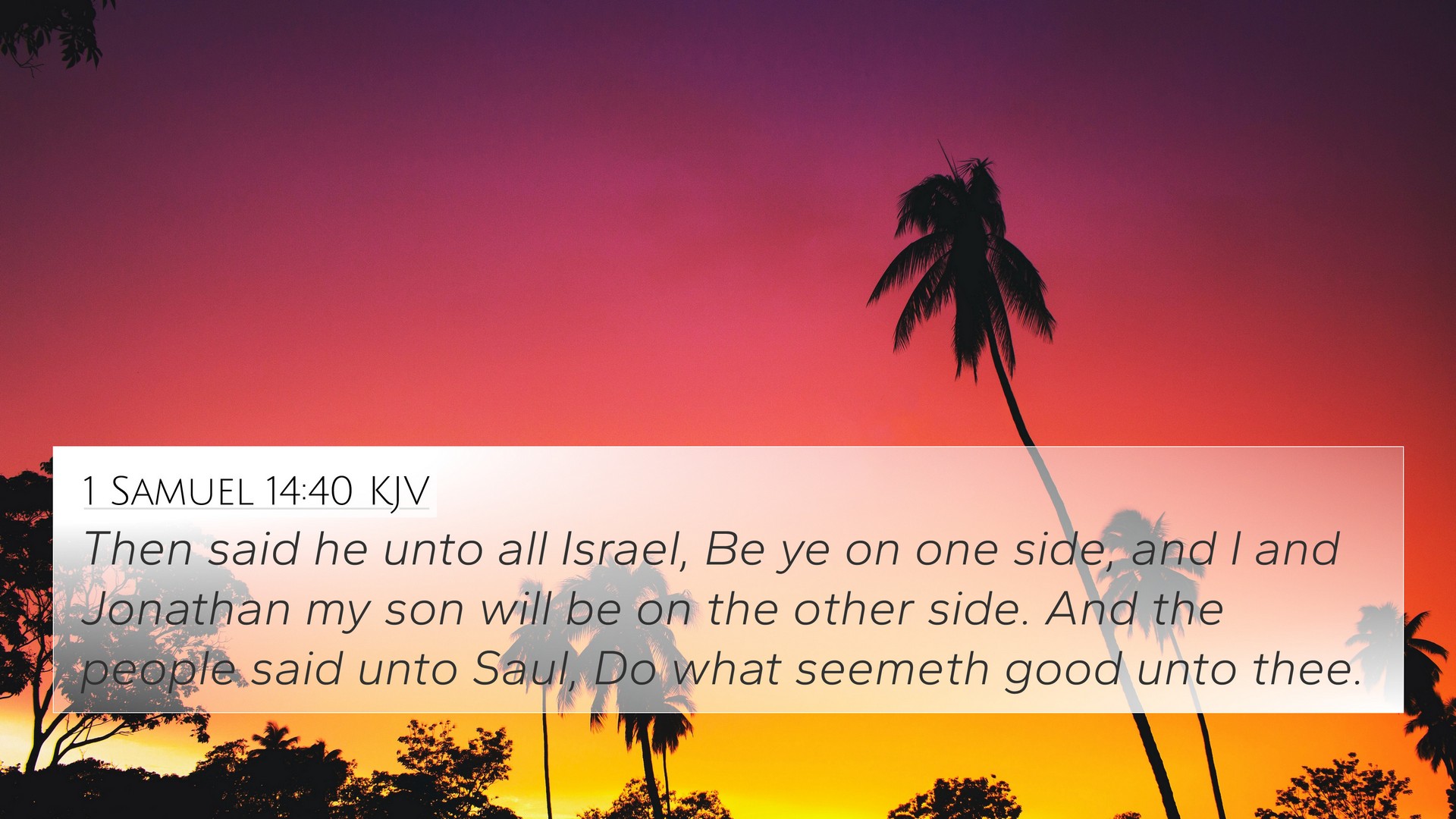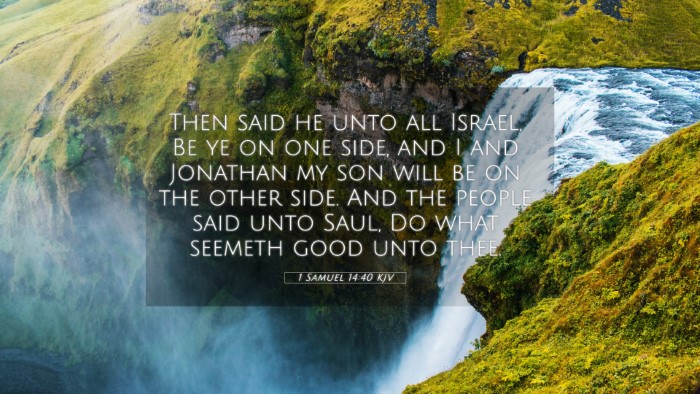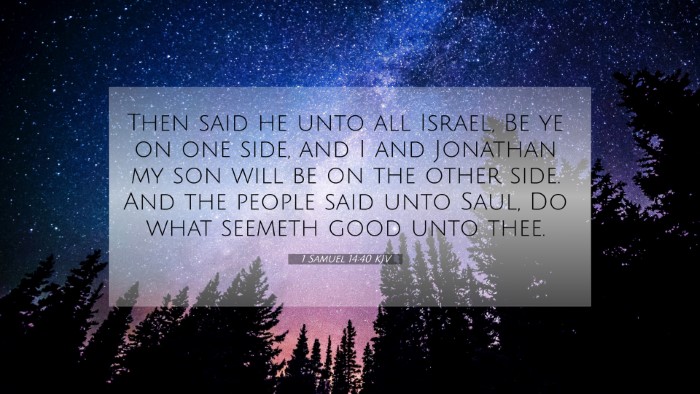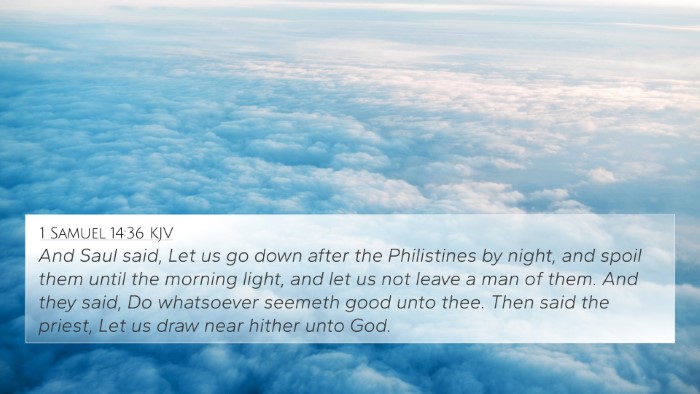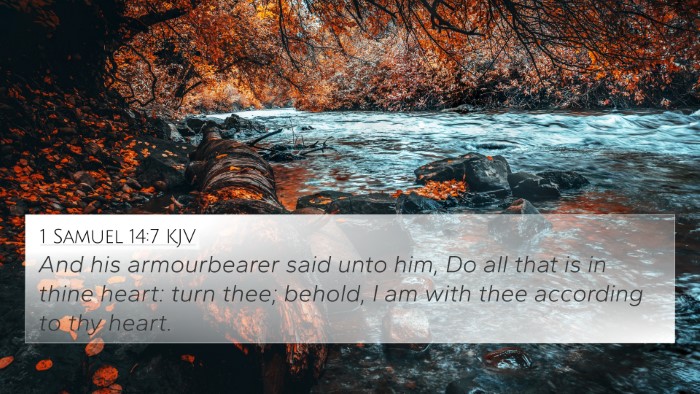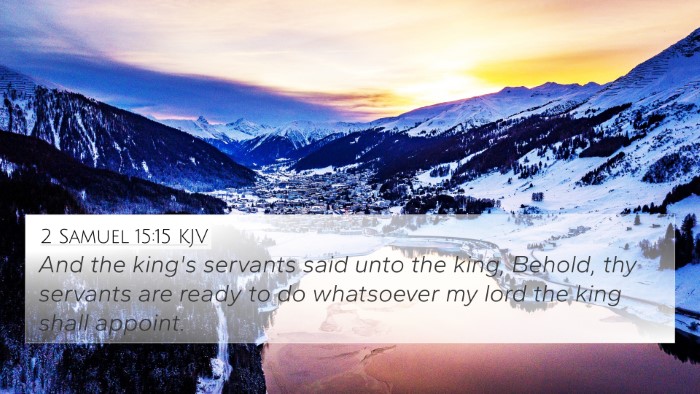Understanding 1 Samuel 14:40
This verse reads:
“Then Saul said, ‘Cast lots between me and Jonathan my son.’ And Jonathan was taken.” (1 Samuel 14:40)
In this passage, King Saul seeks to clarify God's will in a time of crisis. The context involves a battle against the Philistines, during which Saul's command had not gone as planned, and he was looking for divine guidance.
Commentary Insights
Matthew Henry's Commentary
Matthew Henry emphasizes the seriousness of Saul's situation and the urgency with which he sought to know God’s will. He notes that while Saul had just made his son Jonathan a target by cursing anyone who eats during the battle, this verse reveals Saul's desperation to understand God's favor in the conflict. The casting of lots was a common biblical practice to discern God's intentions. This practice mirrors similar instances throughout Scripture where lots were cast to ascertain divine approval or disapproval.
Albert Barnes' Commentary
Albert Barnes highlights the significance of the lot casting itself. He indicates that casting lots was a method used to seek God’s direction, as seen in Proverbs 16:33: “The lot is cast into the lap, but its every decision is from the LORD.” This reinforces the understanding that believers sought God’s will actively in critical situations. Barnes points out that this moment showcases Saul’s journey from being a self-reliant king to one who is acknowledging the need for divine guidance.
Adam Clarke's Commentary
Adam Clarke provides insight into the implications of this action. He notes the irony of Saul's proclamation concerning his son Jonathan, where just moments before, he had declared that whoever ate would be cursed. Clarke urges the reader to consider the contrast between Saul's leadership and Jonathan's faithful character. This moment of casting lots ultimately leads to the revelation of Jonathan's breach of Saul's command during the battle, highlighting themes of loyalty and obedience.
Thematic Connections and Cross-references
This passage serves as a pivotal moment that reveals the nature of Saul's reign and his relationship with God. It can be linked to several relevant scriptures:
- Proverbs 16:33 - "The lot is cast into the lap, but its every decision is from the LORD." This verse confirms the belief that divine sovereignty governs the outcome of decisions made by lots.
- Acts 1:26 - "And they cast lots for them, and the lot fell on Matthias; and he was numbered with the eleven apostles." The New Testament portrays similar practices in decision-making, emphasizing the continuity of seeking divine insight through casting lots.
- 1 Chronicles 24:5 - “Thus they were divided by lot, one group as another, for the governors of the sanctuary and the governors of the house of God.” This further demonstrates the practice in the Old Testament to determine God’s will.
- Joshua 7:14 - "In the morning therefore you shall be brought according to your tribes. And it shall be that the tribe which the LORD takes shall come according to families; and the family which the LORD takes shall come by households; and the household which the LORD takes shall come man by man." This shows an earlier instance of using lots for divine guidance.
- 1 Samuel 10:20-21 - "When Samuel had caused all the tribes of Israel to come near, the tribe of Benjamin was taken. When he had caused the tribe of Benjamin to come near by their families, the family of Matri was taken. And Saul the son of Kish was taken." This is another example of how lots were used to select leaders in Israel.
- Esther 3:7 - “In the first month, which is the month of Nisan, in the twelfth year of King Ahasuerus, they cast Pur, that is, the lot, before Haman to determine the day and the month.” This illustrates the ongoing use of casting lots throughout Israel's history in critical decisions.
- Psalm 22:18 - "They divide my garments among them, and for my clothing they cast lots." This prophetic image foreshadows the events during Jesus’ crucifixion, indicating a continuity of practice and its significance.
- Luke 1:9 - "According to the custom of the priesthood, he was chosen by lot to enter the temple of the Lord and burn incense." Again, illustrating the role of lots in religious rites and significant decisions.
Scriptural Connection and Interpretation
These cross-references illuminate the ongoing biblical narrative that encompasses not just this verse in 1 Samuel, but provides a broader understanding of how decision-making steeped in divine inquiry is woven throughout Scripture. Such connections between Bible verses bring to light the consistent theme of seeking God’s will through various methods, notably the casting of lots.
Connections Between the Old and New Testaments
The thread of seeking divine direction is particularly significant. 1 Samuel 14:40 stands as a bridge that connects both testaments, illustrating a foundational practice that continues into the New Testament era. This inter-Biblical dialogue shows how the methods of guidance may evolve, but the reliance on God for decision-making remains constant.
Conclusion
The exploration of 1 Samuel 14:40 reveals critical lessons regarding leadership, divine guidance, and responsiveness to God's will. As we study this verse alongside its cross-references, we gain richer insights into the character of Saul and God’s overarching plan for Israel. This comparative analysis not only deepens our understanding but also enhances our ability to engage with the text through various methods of Bible cross-referencing.
Tools for Bible Cross-Referencing
For anyone seeking to delve deeper, a number of resources and tools can facilitate effective Bible cross-referencing:
- Bible Concordance: Find specific words or themes to explore related verses.
- Bible Cross-Reference Guide: Utilize a codified system for tracing thematic connections across the scriptures.
- Cross-Reference Bible Study: Engage in studies that focus on linking comparable passages.
- Bible Reference Resources: Gather comprehensive materials that provide insights into inter-textual relationships.
Through understanding and applying these tools, you can enrich your study and interpretation of the Bible, encouraging a deeper and more connected engagement with the sacred text.
